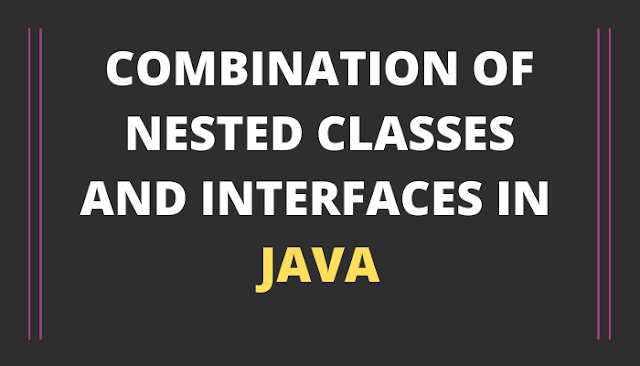Nested classes and interfaces combinations in Java
Here we discuss, 4 types of nested classes and interfaces combination with examples.
- Class inside a Class
- Interface inside a Class
- Interface inside an interface
- Class inside an interface
So lets see all 4 categories one one by with examples.
1. Class inside a Class
Class inside another class refer as nested class. The class written within is called the nested class, and the class that holds the inner class is called the outer class.
class Outer {
class Inner {
public void innerMethod() {
System.out.println("Class inside a Class Example");
}
}
public static void main(String[] args) {
Outer.Inner obj = new Outer().new Inner();
obj.innerMethod();
// We can also do following way
// new Outer().new Inner().innerMethod();
}
}
We can not create inner class object until outer class object is not created.
2. Interface inside a Class
We can also use interface inside class same as nested class. As interface is abstract, so we can define only abstract method and implements that interface whoever class implements interface.
We can multiple implementation of particular interface inside nested class. lets see code of interface inside class.
class ProgrammingLanguages {
interface Programming {
public void getLanguageName();
}
class Java implements Programming {
@Override
public void getLanguageName() {
System.out.println("Java Language");
}
}
class Python implements Programming {
@Override
public void getLanguageName() {
System.out.println("Python Language");
}
}
public static void main(String[] args) {
new ProgrammingLanguages().new Java().getLanguageName();
new ProgrammingLanguages().new Python().getLanguageName();
}
}
Output :
Java Language
Python Language
3. Interface inside an interface
We can declare interface inside interface. interface which is declared interface is always public and static weather we are declaring or not. example, Map is group key value pair and each key value pair is called an Entry.
Without existing Map object there is no chance Entry object. hence interface Entry defined in Map interface. (If you are open Map.class file you can see there Entry interface is defined inside Map interface).
Every interface present inside interface is always public ans static whether we are declaring or not so we can implement inner interface directly without implementing outer interface.
Whenever we are implementing outer interface, we are not required to implement inner interface. So we can outer and inner interfaces independently. lets see example of that.
public interface OuterInterface {
public void outerMethod();
public interface InnerInterface {
public void innerMethod();
}
}
class OuterInterfaceImp implements OuterInterface {
@Override
public void outerMethod() {
System.out.println("Outer interface implementation");
}
}
class InnerInterfaceImp implements OuterInterface.InnerInterface {
@Override
public void innerMethod() {
System.out.println("Inner interface implementation");
}
}
class Demo {
public static void main(String[] args) {
OuterInterfaceImp obj1 = new OuterInterfaceImp();
obj1.outerMethod();
InnerInterfaceImp obj2 = new InnerInterfaceImp();
obj2.innerMethod();
}
}
Output :
Outer interface implementation
Inner interface implementation
4. Class inside an interface
If functionality of class is closely associated with interface, then it is recommended to declare class inside interface.
Class declared inside interface is always public static weather we declaring or not. So we can directly create object of that class.
If we want to provide default implementation of an interface, we can define class inside interface.
We can also provide other implementation if we want to other than default implementation.
Lets see code.
interface ProgrammingLanguage {
public String getLanguage();
// Default implementation
public class Java implements ProgrammingLanguage {
public String getLanguage() {
return "Java";
}
}
}
// Other implementation if default is not enough
class Python implements ProgrammingLanguage {
public String getLanguage() {
return "Python";
}
}
class Demo {
public static void main(String[] args) {
ProgrammingLanguage.Java obj1 = new ProgrammingLanguage.Java();
System.out.println(obj1.getLanguage());
Python obj2 = new Python();
System.out.println(obj2.getLanguage());
}
}
Output :
Java
Python
In ProgrammingLanguage interface, we define class Java that implements ProgrammingLanguage interface and implemented getLanguage() method. So it is default implementation of class inside interface.
If we want another implementation, then we can also define another class that implements ProgrammingLanguage interface and implement getLanguage() method.
Happy learning... Happy coding...

Comments
Post a Comment